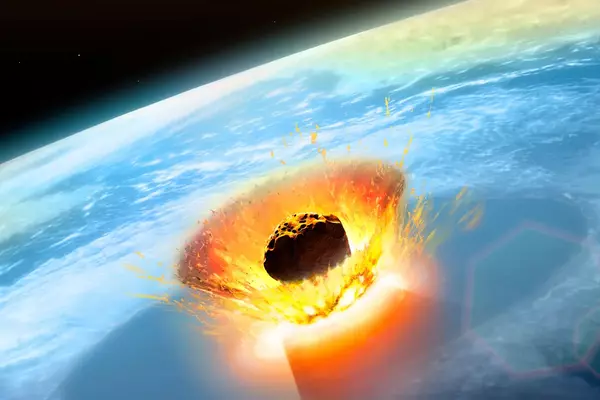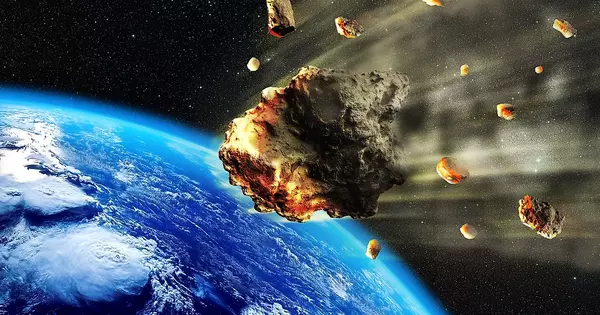Mercury, the closest planet to the Sun, has played an important role in helping scientists understand the Earth’s most massive extinction event, known as the “Great Dying” or the Permian-Triassic (P-T) extinction event. This extinction event, which occurred around 252 million years ago, was the largest and most severe mass extinction in Earth’s history, wiping out more than 96% of marine species and 70% of terrestrial vertebrates.
Studies of rocks and minerals on Mercury have provided valuable insights into the nature of the P-T extinction event. Mercury’s surface is covered in ancient volcanic rocks that are rich in iridium, a metal that is rare on the Earth’s surface but abundant in asteroids and comets. The discovery of high levels of iridium on Mercury led scientists to believe that the P-T extinction event was caused by a massive asteroid impact. This theory was later supported by other studies, including the discovery of large impact craters on Earth that date back to the same time period.
Scientists are focusing on mercury from Siberian volcanoes that ended up in sediments in Australia and South Africa to better understand the cause and progression of the LPME. The Latest Permian Mass Extinction (LPME) was the largest extinction in Earth’s history, killing between 80-90% of life on the planet, but experts have yet to find definitive evidence for what caused the dramatic changes in climate.
An international team of scientists, led by UConn Department of Earth Sciences researchers Professor and Department Head Tracy Frank and Professor Christopher Fielding, is focusing on mercury from Siberian volcanoes that ended up in sediments in Australia and South Africa to better understand the cause and progression of the LPME. The findings were published in Nature Communications. Though the LPME occurred over 250 million years ago, there are parallels to major climate changes occurring today, according to Frank:
“It is pertinent to understanding what may occur on Earth in the future. The primary cause of climate change is associated with a massive injection of carbon dioxide into the atmosphere near the time of the extinction, which resulted in rapid warming.”
It is pertinent to understand what may occur on Earth in the future. The primary cause of climate change is associated with a massive injection of carbon dioxide into the atmosphere near the time of the extinction, which resulted in rapid warming.
Tracy Frank
According to Frank, the rapid warming associated with the LPME is widely accepted to be linked to massive volcanism occurring at a massive deposit of lava known as the Siberian Traps Large Igneous Province (STLIP), but direct evidence was still lacking.
Volcanoes leave important traces in the geological record. With the eruption of the lava, a massive amount of gases, such as CO2 and methane, as well as particulates and heavy metals, were released into the atmosphere and deposited all over the world.
“However, it’s difficult to directly link something like that to the extinction event,” Frank points out. “As geologists, we’re looking for some kind of signature, a smoking gun, so we can absolutely point to the cause.”
The researchers focused on mercury, one of the heavy metals associated with volcanic eruptions, as the smoking gun in this case. The trick is to find areas where that record is still present.
Frank explains that sediments in marine environments contain a continuous record of the earth’s history, acting almost like a tape recorder because deposits are quickly buried and protected. These sediments contain a wealth of information about the extinction and how it occurred in the oceans. On land, it is more difficult to find such well-preserved records from this time period.

To illustrate this, Frank uses Connecticut as an example: the state is rich with 400-500-million-year-old metamorphic rocks at or near the surface, with a covering of glacial deposits dating to around 23,000 years ago.
“There’s a big gap in the record here. You have to be lucky to preserve terrestrial records and that’s why they aren’t as well studied, because there are fewer of them out there,” says Frank.
Not all terrains on the planet have such massive gaps in the geologic record, and previous studies of the LPME have primarily focused on sites in the northern hemisphere. However, the Sydney Basin in Eastern Australia and the Karoo Basin in South Africa are two areas in the southern hemisphere that have an excellent record of the event and have previously been studied by Frank and Fielding. Jun Shen, a colleague and co-author from the China University of Geosciences’ State Key Laboratory of Geological Processes and Mineral Resources, reached out and connected with Frank, Fielding, and other co-authors for samples, with the hope of analyzing them for mercury isotopes.
According to Frank, Shen was able to analyze the mercury isotopes in the samples and link all of the data together. “It has been discovered that volcanic mercury emissions have a very specific isotopic composition of the mercury that accumulated at the extinction horizon. We can more definitively link the timing of the extinction to this massive Siberian eruption now that we know the age of these deposits. This paper is unique in that we examined not only mercury but also the isotopic composition of mercury from samples collected in the high southern latitudes for the first time.”
This precise timing has been worked on by scientists, but as Fielding points out, the more we learn, the more complicated it becomes.
“As a starting point, geologists have used radiogenic isotope dating methods to pinpoint the timing of the major extinction event at 251.9 million years. Researchers know when the major extinction event occurred in the marine environment, and it was previously assumed that the terrestrial extinction event occurred concurrently.”
In Frank and Fielding’s previous research, they found that the extinction event on land happened 200-600,000 years earlier, however. “That suggests that the event itself wasn’t just one big whammy that happened instantaneously. It wasn’t just one very bad day on Earth, so to speak, it took some time to build and this feeds in well into the new results because it suggests the volcanism was the root cause,” says Fielding.
“That was only the first impact of the biotic crisis on land, and it occurred early. It took some time for it to make its way into the oceans. The event 251.9 million years ago was a major tipping point in the ocean’s environmental conditions, which had deteriorated over time.”
According to Frank, retracing the events requires knowledge from a variety of geologists who specialize in various methods such as sedimentology, geochemistry, paleontology, and geochronology.
Overall, the study of Mercury has provided crucial insights into one of the greatest mysteries in Earth’s history, the P-T extinction event, and has helped scientists piece together the complex causes and effects of this catastrophic event.














